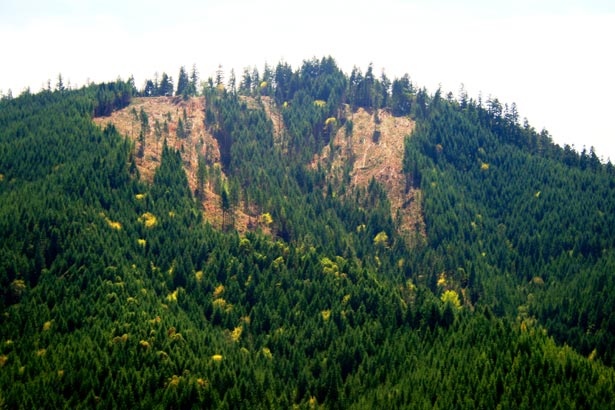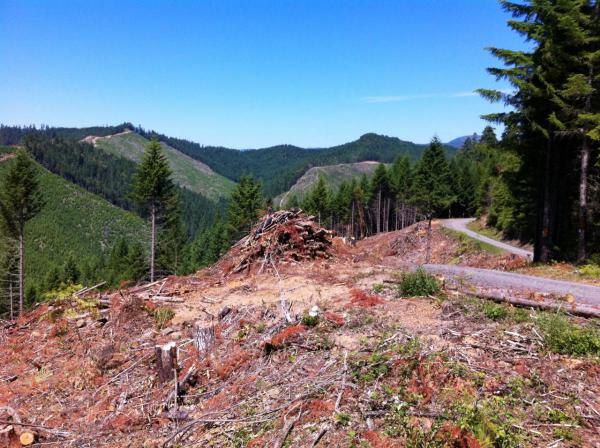The White Castle pilot project is an unusual kind of logging proposal and it’s led to an unusual forest defender vs. forest scientist dynamic. When forestry professor Norm Johnson of OSU, who created the project along with Jerry Franklin of the University of Washington, found out that the Cascadia Forest Defenders (CFD) had taken to the trees last week to stop the proposed logging, he decided he would head out to the site near Roseburg and talk to the protesters. He went to Berkeley in the ’60s, he says, where, “If you weren’t protesting, then you weren’t awake.”
CFD spokesperson Mary Grace says he will receive a warm welcome and that the treesitters have a lot of questions for Johnson.
Mary Grace says that the treesit was noticed by the Bureau of Land Management on June 12, and since then it has been visited by the BLM and state and local police. “It’s very safe at White Castle — we are very protected,” she jokes. She says the site and access to it has not been closed off.
The CFD press release begins, “Cascadia Forest Defenders are meeting the challenge issued by timber-sponsored forest ecologists, Norm Johnson and Jerry Franklin, at the White Castle Timber Sale located 20 miles east of Myrtle Creek.” It continues, “Treesitters, blockaders and the support crew have found their new home near the headwaters of Myrtle Creek on O&C land about to be logged in the name of science.”
The federal O&C lands have been the center of a debate over how to manage them, with the governor, Rep. Peter DeFazio and Sen. Ron Wyden all attempting to put forth proposals in Congress. The main one calls for dividing the forest between conservation and industrial-type logging.
 |
|
The variable retention harvest at Buck Rising, located near White Castle.
Photo Credit: Norm Johnson
|
CFD is targeting scientists rather than the BLM because “the Norm and Jerry show along with the politicians — Wyden, DeFazio — all have the goal of making more land open to logging,” Mary Grace says. She adds, “Most people want forests, not fiber farms” and calls the variable retention harvest a “sneaky backdoor” and a way of saying, “we are not taking all of the forest, so this is not as bad as it could be.”
Johnson and Franklin are both amused at the thought of being linked with the timber industry and its funding. “I am sure that the industry would be aghast to have us identified with their agendas!” Franklin says.
CFD cites Doug of Heiken of Oregon Wild and his criticism of the pilot project as “a cynical attempt to pass off clear-cutting century-old trees as restoration.” Heiken says while Oregon Wild is not involved in the treesit, the group is actively protesting the project. He says, “Oregon Wild is concerned that one million acres of clear-cuts are going to slip through under the label of ‘ecological forestry.’”
Johnson says that clear-cutting (also known as a regeneration harvest) and a variable retention harvest (VRH) are not the same, scientifically, and that they have very different ecological outcomes. “Here’s our puzzle,” he says, “we wanted to create a silvicultural strategy in which we could actually not create a tree farm, but as best we can re-reate a forest.” He says this strategy uses approaches that retain the cycle a forest normally has.
White Castle is a native stand — it has never been logged — whereas the other pilots, including one near Eugene, are in previously logged areas. He says the site “does take your breath away a little.” One goal of the projects, Johnson says, is to create “early seral habitat,” with its bushes, forbs and hardwoods, and help the wildlife that depends on it. “Why wait until they are threatened and endangered?” he asks. Such habitat is lacking in industrial forestland, which uses pesticides to get rid of it. The goal of a VRH is to re-create a more natural forest and to allow for logging as the BLM, which Johnson says no longer logs old growth in western Oregon, runs out of stands of trees to thin.
But if you make even a logged forest complex and beautiful, then Johnson asks, “Do we have the heart to harvest it?” He says, “You see that in the complexity of White Castle; I don’t have the answers, but we need science to illustrate the implications of policy.”
Johnson goes out to the White Castle site to speak with the CFD treesitters as well as to the nearby Buck Rising pilot project on June 20.
Web Extra

Logging at Buck Rising with clear-cuts in the background, courtesy Oregon Wild